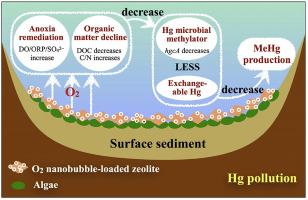当前位置:
X-MOL 学术
›
Water Res.
›
论文详情
Our official English website, www.x-mol.net, welcomes your feedback! (Note: you will need to create a separate account there.)
Mitigation of methylmercury production in eutrophic waters by interfacial oxygen nanobubbles.
Water Research ( IF 12.8 ) Pub Date : 2020-01-30 , DOI: 10.1016/j.watres.2020.115563 Xiaonan Ji 1 , Chengbin Liu 2 , Meiyi Zhang 3 , Yongguang Yin 3 , Gang Pan 4
Water Research ( IF 12.8 ) Pub Date : 2020-01-30 , DOI: 10.1016/j.watres.2020.115563 Xiaonan Ji 1 , Chengbin Liu 2 , Meiyi Zhang 3 , Yongguang Yin 3 , Gang Pan 4
Affiliation

|
In mercury (Hg)-polluted eutrophic waters, algal blooms are likely to aggravate methylmercury (MeHg) production by causing intensified hypoxia and enriching organic matter at the sediment-water interface. The technology of interfacial oxygen (O2) nanobubbles is proven to alleviate hypoxia and may have potential to mitigate the risks of MeHg formation. In this study, incubation column experiments were performed using sediment and overlying water samples collected from the Baihua Reservoir (China), which is currently suffering from co-contamination of Hg and eutrophication. The results indicated that after the application of O2 nanobubbles, the %MeHg (ratio of MeHg to total Hg) in the overlying water and surface sediment decreased by up to 76% and 56% respectively. In addition, the MeHg concentrations decreased from 0.54 ± 0.15 to 0.17 ± 0.01 ng L-1 in the overlying water and from 56.61 ± 9.23 to 25.48 ± 4.08 ng g-1 in the surface sediment. The decline could be attributed to the alleviation of anoxia and the decrease of labile organic matter and bioavailable Hg. In addition, hgcA gene abundances in the overlying water and surface sediment decreased by up to 69% and 44% after the addition of O2 nanobubbles, as is consistent with MeHg occurrence in such areas. Accordingly, this work proposed a promising strategy of using interfacial oxygen nanobubbles to alleviate the potentially enhanced MeHg production during algal bloom outbreaks in Hg-polluted eutrophic waters.
更新日期:2020-01-31


























 京公网安备 11010802027423号
京公网安备 11010802027423号